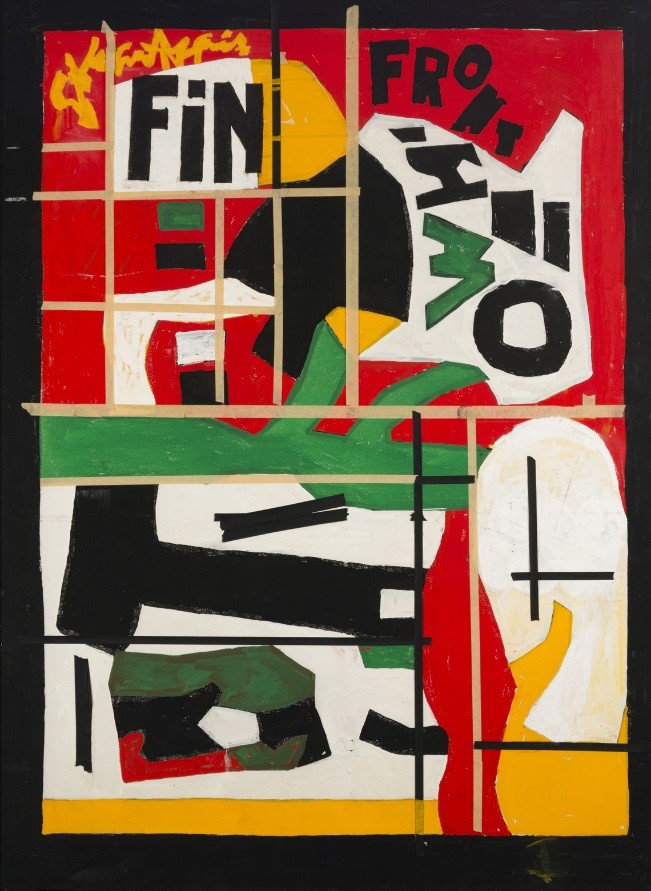When Stuart Davis passed away in 1964, he left an amazing body of work spanning the first half of the 20th century that reflected, through his very personal and particular evolutions in style and approach, this radically transformative era in American history. From his early realist paintings influenced by Robert Henri and the Ashcan School, and his series of drawings for the leftist publication The Masses, through to his embrace of modern art styles of European artists like Picasso, Matisse, and Léger (whose work helped him develop his own unique approach to painting), Stuart Davis marched to the swinging beat of his own creative drum.
One of the most poignant moments in our current exhibition of the artist’s work, Stuart Davis: In Full Swing, occurs at the very end, when we reach his final work, titled Fin. By this point, we’ve walked with Stuart through the six decades of his artmaking. We began with a 19-year-old man’s self-portrait that revealed a wealth of talent and promise, and a young man who scarcely knew where his life, career, and art path would take him. We joined him in Paris in 1928-1929 where he met many of his art idols, married the woman he loved, and fell in love with France and its culture. We spent time with him during the Great Depression as he worked for the Works Progress Administration and fought for artists’ rights. We endured a rough decade in the 1940s when his health troubles nearly took his life, and then we celebrated his triumph in the 1950s as his art took on new life and he found himself “in full swing” at the prime of his artistic practice.
This brings us to the final gallery, containing five works that show an artist paring down his color pallete and continuing to play with composition and form. The work is mature yet imaginative, and one feels as though Davis was onto something new and innovative again. He was in his 70s, and he had a young son named Earl. In the photograph below, we see Stuart and Earl Davis together in 1964.

Stuart and Earl Davis, 1964, photograph by William Innes Homer, courtesy of Art News
The canvas just behind Earl turned out to be Davis’s final work, posthumously titled Fin. As Earl Davis himself told me during his visit to Crystal Bridges in September, this picture was taken just two days before his father died. If you look closely at the top-left corner of the canvas (just above Earl’s head), the word “Fin” has not yet been painted into the picture. Apparently, the evening after this photo was made, Davis watched a French film on television. At that time films often closed with a title frame marking “The End” of the story, and “Fin” means “end” in French. As he so often enjoyed including words in his work, Davis decided to paint “Fin” onto his canvas before retiring to bed. That night, on June 24, 1964, Stuart Davis suffered a stroke and died in the ambulance on the way to New York’s Roosevelt Hospital. Fin, it turns out, was to mark (literally and figuratively) “the end” of a blazing career of a true American original who said in 1962, “I couldn’t have painted any other way than I did. It simply didn’t interest me.”
Fellow artist and close friend Julian Levi gave a eulogy for Stuart Davis to the American Academy of Arts and Letters, excerpted here:[i]
It is startling to realize that before Stuart Davis there was no American painting which was, in subject motivation at least, indigenous. All of our previous painting had sprung from sources in our colonial past – specifically from Europe. Unencumbered by nostalgia (which he loathed) Davis perceived with stunning clarity the visual phenomenon of twentieth-century America, and in so doing, revealed it to all of us in a metaphor which seemed specially invented for the purpose. He nailed down in colors of the wildest intensity the clanging vulgarity, the energy, the mechanized, the dehumanized statement of our civilization’s shrill heartbeat, all in the hard rhythms of jazz which he loved obsessively.
Stuart died on June twenty-fourth in an ambulance en route to Roosevelt Hospital. I cannot help speculating how this curiously apt circumstance would have appealed to his sense of irony – this fast-moving vehicle, siren blaring, dashing through crowded streets festooned with neon light – and not making it. Being a rationalist with a particularly skeptical attitude towards the medical profession, he would have understood the failures in the improvisations characteristic of our life, without questioning their authenticity.
I, too, cannot help but think of this poignant example of an artist’s death as ringing true somehow to the spirit of the artist himself. Continually creating work until the very end, Fin leaves us with a glimpse into the artist’s process, an unfinished canvas itself “in full swing.”
Stuart Davis: In Full Swing, on view through January 1, 2018, is the first large-scale exhibition of the artist’s work in over 20 years.

Stuart Davis’s gravestone
[i] Cooper, Harry and Barbara Haskell. Stuart Davis: In Full Swing. 2016: National Gallery of Art, Washington; Whitney Museum of American Art, New York; DelMonico Books, Prestel, Munich, London, New York. p. 221.




